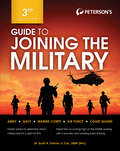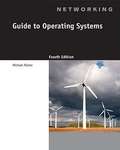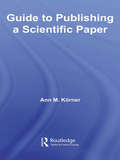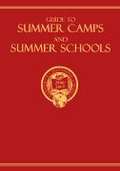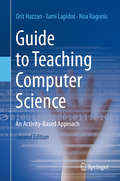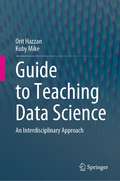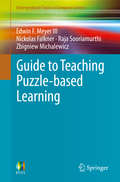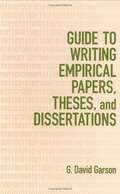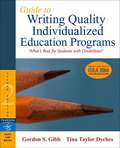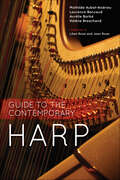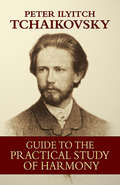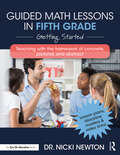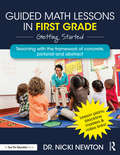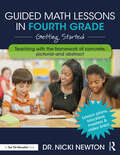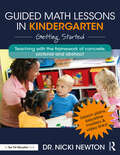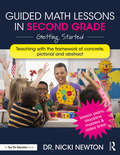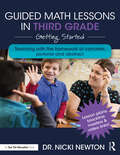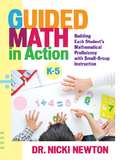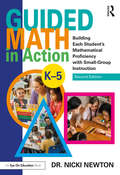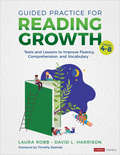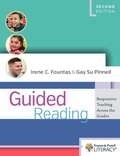- Table View
- List View
Guide to Joining the Military
by Peterson'sGuide to Joining the Military includes topics like: women in the military, details on opportunities available within all branches of the military, what to expect from a military career, information on joining the national guard and reserve, coverage of the ASVAB examination, details on the physical exam and background investigation, basic training facts (daily schedules, training regimens, physical conditioning and more).
Guide to Operating Systems (Fourth Edition)
by Michael Palmer Michael WaltersGet the latest theory and technical information for working on Windows, Mac OS, and UNIX/Linuxplatforms with GUIDE TO OPERATING SYSTEMS, 4E. Topics include operating system theory, installation, upgrading, configuring (operating system and hardware), file systems, security, hardware options, storage, resource sharing, network connectivity, maintenance, and troubleshooting. Designed to be easily understood and highly practical, GUIDE TO OPERATING SYSTEMS, 4E is the resource readers need for deepening their understanding of different operating systems. GUIDE TO OPERATING SYSTEMS, 4E prepares readers to understand the fundamental concepts of computer operating systems. The book specifically addresses Windows XP, Windows Vista, Windows 7, Windows Server 2003 and Windows Server 2003 R2, Windows Server 2008 and Windows Server 2008 R2, SUSE Linux, Fedora Linux, Red Hat Linux, and Mac OS X (Panther, Tiger, Leopard, and Snow Leopard), and provides information on all network operating subjects.
Guide to Publishing a Scientific Paper
by Ann M. Körner"Guide to Publishing a Scientific Paper" provides researchers in every field of the biological, physical and medical sciences with all the information necessary to prepare, submit for publication, and revise a scientific paper. The book includes details of every step in the process that is required for the publication of a scientific paper, for example, use of correct style and language choice of journal, use of the correct format, and adherence to journal guidelines submission of the manuscript in the appropriate format and with the appropriate cover letter and other materials the format for responses to reviewers' comments and resubmission of a revised manuscript The advice provided conforms to the most up-to-date specifications and even the seasoned writer will learn how procedures have changed in recent years, in particular with regard to the electronic submission of manuscripts. Every scientist who is preparing to write a paper should read this book before embarking on the preparation of a manuscript. This useful book also includes samples of letters to the Editor and responses to the Editor's comments and referees' criticism. In addition, as an Appendix, the book includes succinct advice on how to prepare an application for funding. The author has edited more than 7,500 manuscripts over the past twenty years and is, consequently, very familiar with all of the most common mistakes. Her book provides invaluable and straightforward advice on how to avoid these mistakes. Dr. Körner is a professional editor and writer. She has an undergraduate degree from the University of Cambridge and a doctorate in Molecular Biophysics and Biochemistry from Yale University.
Guide to Teaching Computer Science
by Tami Lapidot Orit Hazzan Noa RagonisThis guide presents both a conceptual framework and detailed implementation guidelines for general computer science (CS) teaching. The content is clearly written and structured to be applicable to all levels of CS education and for any teaching organization, without limiting its focus to instruction for any specific curriculum, programming language or paradigm. Features: presents an overview of research in CS education; examines strategies for teaching problem-solving, evaluating pupils, and for dealing with pupils' misunderstandings; provides learning activities throughout the book; proposes active-learning-based classroom teaching methods, as well as methods specifically for lab-based teaching; discusses various types of questions that a CS instructor, tutor, or trainer can use for a range of different teaching situations; investigates thoroughly issues of lesson planning and course design; describes frameworks by which prospective CS teachers gain their first teaching experience.
Guide to Teaching Computer Science: An Activity-Based Approach
by Tami Lapidot Orit Hazzan Noa RagonisThis concise yet thorough textbook presents an active-learning model for the teaching of computer science. Offering both a conceptual framework and detailed implementation guidelines, the work is designed to support a Methods of Teaching Computer Science (MTCS) course, but may be applied to the teaching of any area of computer science at any level, from elementary school to university. This text is not limited to any specific curriculum or programming language, but instead suggests various options for lesson and syllabus organization.Fully updated and revised, the third edition features more than 40 new activities, bringing the total to more than 150, together with new chapters on computational thinking, data science, and soft concepts and soft skills. This edition also introduces new conceptual frameworks for teaching such as the MERge model, and new formats for the professional development of computer science educators.Topics and features: includes an extensive set of activities, to further support the pedagogical principles outlined in each chapter; discusses educational approaches to computational thinking, how to address soft concepts and skills in a MTCS course, and the pedagogy of data science (NEW); focuses on teaching methods, lab-based teaching, and research in computer science education, as well as on problem-solving strategies; examines how to recognize and address learners’ misconceptions, and the different types of questions teachers can use to vary their teaching methods; provides coverage of assessment, teaching planning, and designing a MTCS course; reviews high school teacher preparation programs, and how prospective teachers can gain experience in teaching computer science.This easy-to-follow textbook and teaching guide will prove invaluable to computer science educators within all frameworks, including university instructors and high school teachers, as well as to instructors of computer science teacher preparation programs.
Guide to Teaching Data Science: An Interdisciplinary Approach
by Orit Hazzan Koby MikeData science is a new field that touches on almost every domain of our lives, and thus it is taught in a variety of environments. Accordingly, the book is suitable for teachers and lecturers in all educational frameworks: K-12, academia and industry.This book aims at closing a significant gap in the literature on the pedagogy of data science. While there are many articles and white papers dealing with the curriculum of data science (i.e., what to teach?), the pedagogical aspect of the field (i.e., how to teach?) is almost neglected. At the same time, the importance of the pedagogical aspects of data science increases as more and more programs are currently open to a variety of people.This book provides a variety of pedagogical discussions and specific teaching methods and frameworks, as well as includes exercises, and guidelines related to many data science concepts (e.g., data thinking and the data science workflow), main machine learning algorithms and concepts (e.g., KNN, SVM, Neural Networks, performance metrics, confusion matrix, and biases) and data science professional topics (e.g., ethics, skills and research approach).Professor Orit Hazzan is a faculty member at the Technion’s Department of Education in Science and Technology since October 2000. Her research focuses on computer science, software engineering and data science education. Within this framework, she studies the cognitive and social processes on the individual, the team and the organization levels, in all kinds of organizations.Dr. Koby Mike is a Ph.D. graduate from the Technion's Department of Education in Science and Technology under the supervision of Professor Orit Hazzan. He continued his post-doc research on data science education at the Bar-Ilan University, and obtained a B.Sc. and an M.Sc. in Electrical Engineering from Tel Aviv University.
Guide to Teaching Puzzle-based Learning
by Edwin F. Meyer Nickolas Falkner Raja Sooriamurthi Zbigniew MichalewiczThis book provides insights drawn from the authors' extensive experience in teaching Puzzle-based Learning. Practical advice is provided for teachers and lecturers evaluating a range of different formats for varying class sizes. Features: suggests numerous entertaining puzzles designed to motivate students to think about framing and solving unstructured problems; discusses models for student engagement, setting up puzzle clubs, hosting a puzzle competition, and warm-up activities; presents an overview of effective teaching approaches used in Puzzle-based Learning, covering a variety of class activities, assignment settings and assessment strategies; examines the issues involved in framing a problem and reviews a range of problem-solving strategies; contains tips for teachers and notes on common student pitfalls throughout the text; provides a collection of puzzle sets for use during a Puzzle-based Learning event, including puzzles that require probabilistic reasoning, and logic and geometry puzzles.
Guide to Writing Empirical Papers, Theses, and Dissertations
by G. David GarsonDescribes the quantitative research process--framing analytical questions, developing a comprehensive outline, providing a road map for the reader, and accessing indispensable computer and program tools. Supplies end-of-chapter checklists, extensive examples, and bibliographies.
Guide to Writing Quality Individualized Education Programs
by Gordon S. Gibb Tina Taylor DychesThis bestselling guide helps users reduce the complexity of IEP development to seven basic steps, based on the requirements of IDEA 2004. It helps prepare teacher candidates with excellent IEP-writing skills, and gives in-service teachers an accurate resource for their continuing professional development in this critical area. Features include step-by-step instruction for IEP development, using explanation, modeling, practice and formative feedback for self-guided individual or group learning. The introduction of the second edition provides a quick overview of special education and the requirements of IDEA 2004. Additionally, the second edition is based on new case studies with complete IEPs for four elementary and secondary students with mild/moderate and severe disabilities, including transition planning. It also provides practice in differing requirements for students taking alternative assessments and features "Answers to Tricky Questions About IEPs" that teachers often encounter.
Guide to the Contemporary Harp
by Mathilde Aubat-Andrieu Laurence Bancaud Aurélie Barbé Hélène BreschandHarps and harp music have enjoyed a renaissance over the past century and today can be heard in a broad array of musical contexts. Guide to the Contemporary Harp is a comprehensive resource that examines the vibrant present-day landscape of the harp. The authors explore the instrument from all angles, beginning with organology; moving through composition, notation, and playing techniques; and concluding with the contemporary repertoire for the harp. The rapid diversification in these areas of harp performance is the result of both technological innovations in harp making, which have produced the electric harp and MIDI harp, and innovative composers and players. These new instruments and techniques have broadened the concept of what is possible and what constitutes harp music for today. Guide to the Contemporary Harp is an essential guide for any harpist looking to push the instrument and its music to new heights.
Guide to the Practical Study of Harmony (Dover Books on Music)
by Peter Ilyitch TchaikovskyWritten during Tchaikovsky’s years as professor at the renowned Moscow Conservatory, this volume presents a clear and thorough introduction to the study of harmony. The great Russian composer expounded upon his views of music while he was in the full flower of his creative powers, offering students a chance to learn the discipline’s fundamentals from one of its great masters. Out of print for decades and exceedingly rare in its original edition, Tchaikovsky’s Guide to the Practical Study of Harmony possesses an intrinsic historical interest, yet remains as useful and instructive today as it was a century ago. A complete course in writing music, this excellent manual features numerous examples and exercises. It functions equally well as a classroom text, an adjunct to private instruction, or as a guide to individual musicians.
Guided Flight Discovery: Instrument/Commercial Textbook
by Jeppesen SandersonJeppesen's Guided Flight Discovery Instrument/Commercial textbook provides the most complete explanations of aeronautical concepts for pilots pursuing a instrument rating or commercial certificate. This colorful textbook is your primary source for initial study and review. It includes the Principles of Instrument Flight, The Flight Environment, Instrument Charts and Procedures, Aviation Weather and IFR Flight Operations and Commercial Pilot Operations, as well as an introductory look at Building Professional Experience. The most comprehensive and visually appealing Instrument/Commercial textbook ever! The Instrument/Commercial textbook is your primary source for initial study and review to achieve an instrument rating or commercial pilot certificate. The intuitive organization and colorful presentation of the manual will help you learn quickly from the start. The text contains complete and concise explanations of the advanced concepts and ideas that every instrument and commercial pilot needs to know with the subjects arranged in a logical manner to build upon previously introduced topics. You can expand your knowledge of specific subjects and the world of aviation by exploring the Discovery Insets, which are strategically placed throughout the chapters. To help you understand how your mind and body function while you fly, human factors principles are presented in Human Element Insets. Throughout the manual, concepts that directly relate to FAA test questions are described in FAA Question Insets. To help you effectively review material, key terms are highlighted throughout the text and listed at the end of each section along with a checklist, which summarizes important concepts. Additionally, you can evaluate your understanding of material by completing the associated questions at the end of each section. Jeppesen Part Number JS314520
Guided Math Lessons in Fifth Grade: Getting Started
by Nicki NewtonGuided Math Lessons in Fifth Grade provides detailed lessons to help you bring guided math groups to life. Based on the bestselling Guided Math in Action, this practical book offers 16 lessons, taught in a round of 3—concrete, pictorial and abstract. The lessons are based on the priority standards and cover fluency, word problems, fractions, and decimals. Author Dr. Nicki Newton shows you the content, as well as the practices and processes, that should be worked on in the lessons so that students not only learn the content but also how to solve problems, reason, communicate their thinking, model, use tools, use precise language and see structure and patterns. Throughout the book, you’ll find tools, templates and blackline masters so that you can instantly adapt the lesson to your specific needs and use it right away. With the easy-to-follow plans in this book, students can work more effectively in small guided math groups—and have loads of fun along the way! Remember that guided math groups are about doing the math. So throughout these lessons, you will see students working with manipulatives to make meaning, doing mathematical sketches to show what they understand and can make sense of the abstract numbers. When students are given the opportunities to make sense of the math in hands-on and visual ways, then the math begins to make sense to them!
Guided Math Lessons in First Grade: Getting Started
by Nicki NewtonGuided Math Lessons in First Grade provides detailed lessons to help you bring guided math groups to life. Based on the bestselling Guided Math in Action, this practical book offers 16 lessons, taught in a round of 3—concrete, pictorial, and abstract. The lessons are based on the priority standards and cover fluency, word problems, operations and algebraic thinking, and place value. Author Dr. Nicki Newton shows you the content as well as the practices and processes that should be worked on in the lessons, so that students not only learn the content but also how to solve problems, reason, communicate their thinking, model, use tools, use precise language, and see structure and patterns. Throughout the book, you’ll find tools, templates, and blackline masters so that you can instantly adapt the lesson to your specific needs and use it right away. With the easy-to-follow plans in this book, students can work more effectively in small guided math groups—and have loads of fun along the way!
Guided Math Lessons in Fourth Grade: Getting Started
by Nicki NewtonGuided Math Lessons in Fourth Grade provides detailed lessons to help you bring guided math groups to life. Based on the bestselling Guided Math in Action, this practical book offers 16 lessons, taught in a round of three–concrete, pictorial and abstract. The lessons are based on the priority standards and cover fluency, word problems, fractions and place value. Author Dr. Nicki Newton shows you the content as well as the practices and processes that should be worked on in the lessons, so that students not only learn the content but also how to solve problems, reason, communicate their thinking, model, use tools, use precise language, and see structure and patterns. Throughout the book, you’ll find tools, templates and blackline masters so that you can instantly adapt the lesson to your specific needs and use it right away. With the easy-to-follow plans in this book, students can more work effectively in small guided math groups—and have loads of fun along the way! Remember that guided math groups are about doing the math. So doing mathematical sketches to show what they understand and can make sense of the abstract numbers. When students are given the opportunities to make sense of the math in hands-on and visual ways, then the math begins to make sense!
Guided Math Lessons in Kindergarten: Getting Started
by Nicki NewtonGuided Math Lessons in Kindergarten provides detailed lessons to help you bring guided math groups to life. Based on the bestselling Guided Math in Action, this practical book offers 16 lessons, taught in a round of three—concrete, pictorial and abstract. The lessons are based on the priority standards and cover fluency, word problems, counting and cardinality, and place value. Author Dr. Nicki Newton shows you the content as well as the practices and processes that should be worked on in the lessons, so that students not only learn the content but also how to solve problems, reason, communicate their thinking, model, use tools, use precise language, and see structure and patterns. Throughout the book, you’ll find tools, templates and blackline masters so that you can instantly adapt the lesson to your specific needs and use it right away. With the easy-to-follow plans in this book, students can more work effectively in small guided math groups—and have loads of fun along the way! Remember that guided math groups are about doing the math. So throughout these lessons you will see students working with manipulatives to make meaning, doing mathematical sketches to show what they understand and can make sense of the abstract numbers. When students are given the opportunities to make sense of the math in hands-on and visual ways, then the math begins to make sense to them!
Guided Math Lessons in Second Grade: Getting Started
by Nicki NewtonGuided Math Lessons in Second Grade provides detailed lessons to help you bring guided math groups to life. Based on the bestselling Guided Math in Action, this practical book offers 16 lessons, taught in a round of 3—concrete, pictorial, and abstract. The lessons are based on the priority standards and cover fluency, word problems, operations and algebraic thinking, and place value. Author Dr. Nicki Newton shows you the content as well as the practices and processes that should be worked on in the lessons, so that students not only learn the content but also how to solve problems, reason, communicate their thinking, model, use tools, use precise language, and see structure and patterns. Throughout the book, you’ll find tools, templates, and blackline masters so that you can instantly adapt the lesson to your specific needs and use it right away. With the easy-to-follow plans in this book, students can work more effectively in small guided math groups—and have loads of fun along the way!
Guided Math Lessons in Third Grade: Getting Started
by Nicki NewtonGuided Math Lessons in Third Grade provides detailed lessons to help you bring guided math groups to life. Based on the bestselling Guided Math in Action, this practical book offers 16 lessons, taught in a round of 3—concrete, pictorial and abstract. The lessons are based on the priority standards and cover fluency, word problems, fractions and place value. Author Dr. Nicki Newton shows you the content as well as the practices and processes that should be worked on in the lessons, so that students not only learn the content but also how to solve problems, reason, communicate their thinking, model, use tools, use precise language, and see structure and patterns. Throughout the book, you’ll find tools, templates and blackline masters so that you can instantly adapt the lesson to your specific needs and use it right away. With the easy-to-follow plans in this book, students can work more effectively in small guided math groups—and have loads of fun along the way! Remember that guided math groups are about doing the math. So throughout these lessons you will see students working with manipulatives to make meaning, doing mathematical sketches to show what they understand and can make sense of the abstract numbers. When students are given the opportunities to make sense of the math in hands-on and visual ways, then the math begins to make sense to them!
Guided Math in Action: Building Each Student's Mathematical Proficiency with Small-Group Instruction
by Nicki NewtonTeachers, coaches, and supervisors will learn how to help elementary school students build mathematical proficiency with standards-based, differentiated, small-group instruction with the strategies in this book. Both novice and veteran educators will gain in-depth knowledge for conducting effective guided math lessons, scaffolding learning in small groups, and assessing student learning. Lots of actual templates, graphic organizers, black-line masters, detailed lesson plans, and student work samples are included, as well as vignettes of mini-lessons, center time, small guided math groups, and share time. This practical, hands-on guide will help you... Understand the framework of Guided Math lessons Gain an in-depth look at the role of assessment throughout the Guided Math process Develop an action plan to get started immediately This is a must-have resource for all educators looking for a structure to teach small groups in math that meet the Common Core State Standards for Mathematics.
Guided Math in Action: Building Each Student's Mathematical Proficiency with Small-Group Instruction
by Nicki NewtonLearn how to help elementary students build mathematical proficiency with purposeful, standards-based, differentiated, engaging small-group instruction. This best-selling book from Dr. Nicki Newton provides a repertoire of in-depth strategies for conducting effective guided math lessons, scaffolding and managing learning in small groups, and assessing learning. Dr. Newton shows you the framework for guided math lessons and then helps you develop an action plan to get started. This fully updated second edition features helpful new sections on beliefs, teacher moves, planning, talking and questioning, and kidwatching. It also contains a brand new study guide to help you get the most out of the book and use it with your colleagues. Perfect for teachers, coaches, and supervisors, this popular resource is filled with tools you can use immediately, including anchor charts, schedules, templates, and graphic organizers. With the practical help throughout, you’ll be able to implement Tier 1 and 2 lessons easily. This book will help you guide all your students to becoming more competent, flexible, and confident mathematicians!
Guided Practice for Reading Growth, Grades 4-8: Texts and Lessons to Improve Fluency, Comprehension, and Vocabulary (Corwin Literacy)
by David L. Harrison Laura J. RobbGuided Practice for Reading Growth provides all you need to support middle grade students reading two or more years below grade level. Twenty-four powerful reading lessons feature original poems and short texts that interest students and encourage them to think deeply. This unique book shows you how to: · Build students&’ background knowledge by watching and discussing videos. · Use poems to improve reading and fluency through practice and performance. · Invite students to write about their reading and increase comprehension and recall. · Encourage meaningful talk to enlarge students&’ analytical thinking and understanding.
Guided Practice for Reading Growth, Grades 4-8: Texts and Lessons to Improve Fluency, Comprehension, and Vocabulary (Corwin Literacy)
by David L. Harrison Laura J. RobbGuided Practice for Reading Growth provides all you need to support middle grade students reading two or more years below grade level. Twenty-four powerful reading lessons feature original poems and short texts that interest students and encourage them to think deeply. This unique book shows you how to: · Build students&’ background knowledge by watching and discussing videos. · Use poems to improve reading and fluency through practice and performance. · Invite students to write about their reading and increase comprehension and recall. · Encourage meaningful talk to enlarge students&’ analytical thinking and understanding.
Guided Reading Coaching Tool
by Daphne Byrd Polly WestfallThis handy resource can be used by all teachers, classroom volunteers, and parents for one-to-one or small-group reading instruction. The scripted language and sample questions on each topic (directionality, high-frequency words, comprehension, etc. ) provide the "instructor" with key prompts and reading strategies to support the "reader. " Also includes a reproducible assessment form for identifying students' strengths and weaknesses.
Guided Reading: Responsive Teaching Across the Grades (2nd Edition)
by Gay Su Pinnell Irene FountasMuch has been written on the topic of guided reading over the last twenty years, but no other leaders in literacy education have championed the topic with such depth and breadth as Irene Fountas and Gay Su Pinnell. In the highly anticipated second edition of Guided Reading, Fountas and Pinnell remind you of guided reading's critical value within a comprehensive literacy system, and the reflective, responsive teaching required to realize its full potential. Now with Guided Reading, Second Edition, (re)discover the essential elements of guided reading through: a wider and more comprehensive look at its place within a coherent literacy system a refined and deeper understanding of its complexity an examination of the steps in implementation-from observing and assessing literacy behaviors, to grouping in a thoughtful and dynamic way, to analyzing texts, to teaching the lesson the teaching for systems of strategic actions a rich text base that can support and extend student learning the re-emerging role of shared reading as a way to lead guided and independent reading forward the development of managed independent learning across the grades an in-depth exploration of responsive teaching the role of facilitative language in supporting change over time in students' processing systems the identification of high-priority shifts in learning to focus on at each text level the creation of a learning environment within which literacy and language can flourish. Through guided reading, students learn how to engage in every facet of the reading process and apply their reading power to all literacy contexts. Also check out our new on-demand mini-course: Introducing Texts Effectively in Guided Reading Lessons
